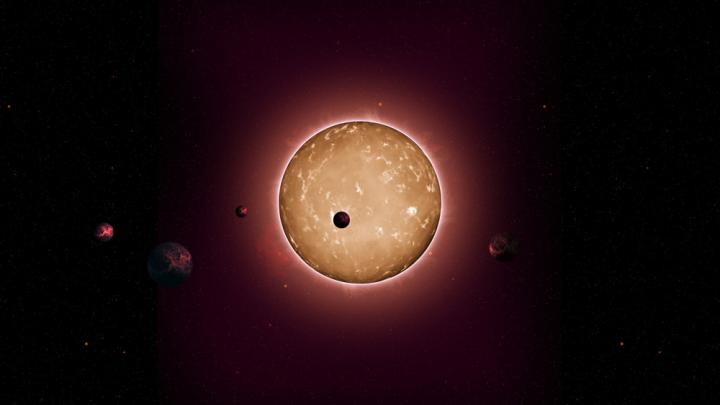Astronomers poring over four years of data from NASA's Kepler spacecraft have discovered a star that's 11.2 billion years old and has at least five Earth-size planets.
"We thus show that Earth-size planets have formed throughout most of the Universe's 13.8-billion-year history, leaving open the possibility for the existence of ancient life in the Galaxy," the astronomers wrote in their paper, "An Ancient Extrasolar System with Five Sub-Earth-Size Planets," published by the Astrophysical Journal. Tiago Campante, a research fellow at the University of Birmingham in the United Kingdom, is leader of the research project and first author of the paper. Steve Kawaler, an Iowa State University professor of physics and astronomy, is a project collaborator and co-author of the paper.

Kepler-444 is a recently discovered star with at least five Earth-size planets. The system is 11.2 billion years old. Credit: Illustration by Tiago Campante/Peter Devine.
The paper describes Kepler-444, a star that's 25 percent smaller than our sun and is 117 light years from Earth. The star's five known planets have sizes that fall between Mercury and Venus. Those planets are so close to their star that they complete their orbits in fewer than 10 days. At that distance, they're all much hotter than Mercury and aren't habitable.
Kawaler said Keppler-444 is very bright and can be easily seen with binoculars.
Kawaler's role within the research team was to help with the stellar seismology work that determined the size of Kepler-444. To do that, Kawaler and the rest of the team studied sound waves within the star. Those sound waves affect the star's temperature, creating pulsating changes in brightness that offer clues to the star's diameter, mass and age.
Kepler takes high-precision measurements of those changes in brightness. That's how Kepler does its primary job: Finding distant planets by measuring tiny changes in brightness as they pass in front of their stars.
"This is one of the oldest systems in the galaxy," Kawaler said of the Kepler discovery, noting that our sun is 4.5 billion years old. "Kepler-444 came from the first generation of stars. This system tells us that planets were forming around stars nearly 7 billion years before our own solar system.
"Planetary systems around stars have been a common feature of our galaxy for a long, long time."
That discovery is going to help astronomers learn even more about the history of the Milky Way.
"From the first rocky exoplanets to the discovery of an Earth-size planet orbiting another star in its habitable zone, we are now getting first glimpses of the variety of Galactic environments conducive to the formation of these small worlds," the astronomers wrote in their new paper. "As a result, the path toward a more complete understanding of early planet formation in the Galaxy starts unfolding before us."